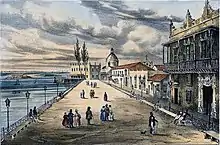La Alameda de Paula, Havana
The Alameda de Paula is a promenade in Havana, Cuba, and was the first to be built in the city.
| La Alameda de Paula | |
|---|---|
 Alameda de Paula, 1947 | |

| |
| General information | |
| Type | Promenade |
| Architectural style | Neoclassical |
| Location | Havana Vieja |
| Town or city | |
| Country | |
| Coordinates | 23.1323°N 82.3480°W |
History

The Alameda de Paula was commissioned by Captain General (Spanish: Capitanía General de Cuba) Felipe de Fons de Viela, member of the court of King Carlos III. It was built by architect Antonio Fernández de Trebejos in 1777. The site of the old Rincón refuse dump, initially the promenade was a dirt track with some benches and flanked by two rows of poplar trees.[1] It was given the name Alameda de Paula because of its proximity to the Hospital and Iglesia of San Francisco de Paula which had been built in 1664. An ornamented marble fountain was built in 1847. Between 1803 and 1805 the pavement was tiled, a fountain and stone benches, lampposts and the marble column were added, it qualified as a pleasant entertainment for the residents of the Villa de San Cristóbal, lacking recreational sites at that time. The Alameda de Paula became one of Havana's most important social and cultural spaces and the model of the Paseo del Prado designed in 1925 by Jean-Claude Nicolas Forestier.
Renovation

The promenade was the subject of various transformations in the course of the 19th century; the embankment was tiled, a fountain was located there and the back of the seats was latticed. By that time it was considered the most popular and busiest place in the city. Toilets were built which increased its popularity. In the 1940s, squares were drawn at its ends, widened, and provided with access stairs and seats, street lamps were updated.[2]
In 1841, the stairs that gave access to the promenade were widened and several lampposts were added. In the year 2000, the Havana promenade was restored and extended until it reached the Iglesia de San Francisco de Paula.[3]
References
- "Alameda de Paula". Retrieved 2020-01-03.
- "Alameda de Paula". Retrieved 2020-01-02.
- "La Iglesia de San Francisco de Paula". Retrieved 2019-01-06.